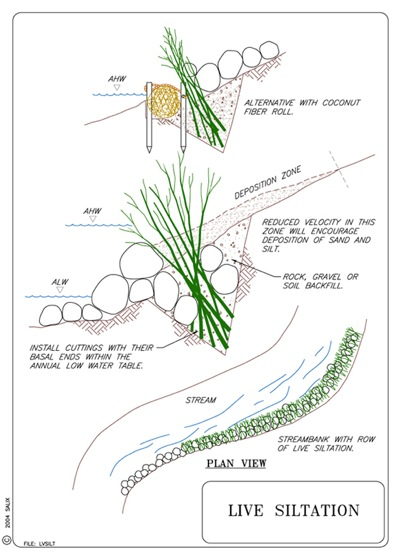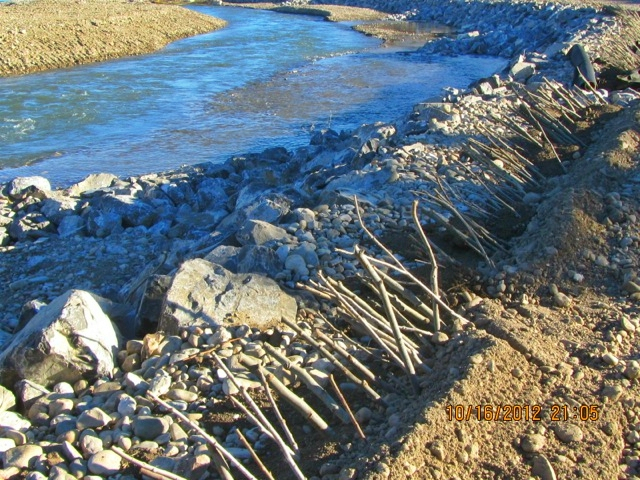26 Sep The Basics of Live Siltation
What is Live Siltation you ask?
First, here is a typical drawing of the BMP:

(Referenced: McCullah, J.A. 2004. ESenSS software. Salix Applied Earthcare. Redding, CA.)
Still unsure?
Live Siltation (also known as Vertical Brush Layering) is a revegetation technique used to secure the toe of a streambank, trap sediments, and create fish rearing habitat. The system can be constructed as a living or a non-living brushy system at the water’s edge.This is a very effective and simple conservation method using local plant materials. This technique is particularly valuable for providing immediate cover and fish habitat while other revegetation plantings become established. The protruding branches provide roughness, slow velocities, and encourage deposition of sediment. The depositional areas are then available for natural recruitment of native riparian vegetation.
Is Live Siltation a BMP that can only be utilized as it’s own whole?
Not only is this an effective BMP on its own, it can be utilized with different techniques and materials to sustain its abilities overtime. Live siltation techniques can be constructed in combination with rock toes, Rootwad Revetments, Coconut Fiber Rolls, Live Fascines, and Brush Mattresses. (more on these to come in furture blogs).
What materials are needed to make Live Siltation a Success?
Specific materials are needed to secure the construction of this particular BMP: Natural stone, willow wattles, logs or root wad revetments. The live siltation will require live branches of shrub willows 1-1.5 m (3.5–5 ft) in length. The branches should be dormant, and need to have the side branches still attached, for continued growth of the natural material. Any woody plant material, such as alder, can be installed for a non-living system.
What does Live Siltation acutally look like out in the Field?
Here is a Case Study of Live Siltation on the Belly River in Alberta, Canada 2012.

As you can see in the picture above, the water it at a lower rusing point, making installation of this method easier to construct, with the water’s edge not at your feet. This also, gives the plant materials to establish their placement within the dirt/rock (roots growing out making secure pacement within the ground), before battleing again the river’s current.
Why would one choose Live Siltation instead of another BMP?
This is a very effective and simple conservation method using local plant materials. This technique is particularly valuable for providing immediate cover and fish habitat while other revegetation plantings become established. The protruding branches provide roughness, slow velocities, and encourage deposition of sediment. The depositional areas are then available for natural recruitment of native riparian vegetation.
What construction needs to occur to secure proper layout of Live Siltation?
You will construct a V-shaped trench at the annual high water (AHW) level, with hand tools or a backhoe (for bigger projects). Excavate a trench so that it parallels the toe of the streambank and is approximately 0.6 m (2 ft) deep. Lay a thick layer of willow branches in the trench so that 1/3 of the length of the branches is above the trench and the branches angle out toward the stream. Place a minimum of 40 willow branches per m (12 branches per ft) in the trench.
Backfill over the branches with a gravel/soil mix and secure the top surface with large washed gravel, bundles/coir logs, or carefully placed rocks. Both the upstream and downstream ends of the live siltation construction need to transition smoothly into a stable streambank to reduce the potential for the system to wash out. More that one row of live siltation can be installed. A living and growing siltation system typically is installed at AHW. A non-living system can be constructed below AHW during low water levels. If it is impossible to dig a trench, the branches can be secured in place with logs, armor rock, bundles made from wattles, or coir logs.
**Note:This technique may be used for velocities up to 2 m/sec (6.6 ft/sec), but velocities should be at least 0.25 m/sec (0.8 ft/sec) for the system to function properly.**
What kind of maintenance/monitoring of this project is needed after completion?
During the first year, the installation should be checked for failures after all 1-year return interval and higher flows, and repaired as necessary. During summer months of the first year, ensure that cuttings are not becoming dehydrated.
Are there any common reasons why implementing Live Siltation has failed?
Cuttings will not promote siltation as well if not located near to or close at the water’s edge. If located further up the bank, cuttings may dry out, and will only trap sediments and slow velocities during high flows. Cuttings may not grow well if not handled properly prior to installation.
Still have questions?
Feel free to leave comments with questions/feedback or e-mail us @ info@sailxaec.com
Thanks for reading!
–The Dirt Time Team
